A System Dynamics Model for Urban Residential Building Stock towards Sustainability: The Case of Jinan, China
Abstract
:1. Introduction
- Develop a system dynamics model for urban residential building stock;
- Simulate and identify the feature of urban residential building stock and relative flow in future;
- Predict the environmental and resource impacts related to the urban residential building stock in future;
- Based on the analysis results, some feasible long-term measures to reduce the environmental and resource problems are proposed and quantitatively evaluated in order to select the most appropriate and effective policy measures to help the decision-making for the urban government.
2. Research Methods
2.1. Causal Loop Diagram
- Demand of new residential building—(+) New construction area—(+) Residential building stock—(−) Demand of new residential building;
- Demand of new residential building—(+) New construction area—(+) Demolition residential building—(−) Residential building stock—(+) Demand of new residential building;
- Demand of new residential building—(+) New construction area—(+) Total amount of C&D waste—(+) C&D waste for landfill—(+) Environmental and resource impacts—(−) Demand of new residential building;
- Demand of new residential building—(+) New construction area—(+) Demolition residential building—(+) Total amount of C&D waste—(+) C&D waste for recycling—(−) Environmental and resource impacts—(+) Demand of new residential building;
- Demand of new residential building—(+) New construction area—(+) Residential building stock—(+) Total amount of C&D waste—(+) C&D waste for recycling—(−) Environmental and resource impacts—(+) Demand of new residential building;
- C&D waste for reusing and recycling—(−) C&D waste for landfill—(−) C&D waste for recycling;
- Demand of new residential building—(+) New construction area—(+) Demand of construction material—(+) Environmental and resource impacts—(−) Demand of new residential building.
2.2. Data Collection
2.3. Stock and Flow Diagram
- Urban population
- 2.
- Per capita floor area
- 3.
- Building structures of new constructions of residential building stock
- 4.
- Urban residential building stock
- 5.
- New urban residential building construction
- 6.
- Demolished residential building area
- 7.
- Lifetime of the residential building
- 8.
- Environmental and resource impacts
2.4. SD Model Validation
3. Simulation Results
4. Scenario Analysis
4.1. Policy Scenario Set
- 1.
- Policy 1
- 2.
- Policy 2
- 3.
- Policy 3
- 4.
- Policy 4
4.2. Scenario Analysis Results
4.2.1. Environmental Impacts
4.2.2. Resource Impacts
4.2.3. GHG Emission
4.3. Sensitivity Analysis
5. Conclusions
Author Contributions
Funding
Institutional Review Board Statement
Informed Consent Statement
Data Availability Statement
Conflicts of Interest
References
- Wu, Z.; Yu, A.T.W.; Shen, L. Investigating the Determinants of Contractor’s Construction and Demolition Waste Management Behavior in Mainland China. Waste Manag. 2017, 60, 290–300. [Google Scholar] [CrossRef]
- Ding, Z.; Zhu, M.; Tam, V.W.Y.; Yi, G.; Tran, C.N.N. A System Dynamics-Based Environmental Benefit Assessment Model of Construction Waste Reduction Management at the Design and Construction Stages. J. Clean. Prod. 2018, 176, 676–692. [Google Scholar] [CrossRef]
- Augiseau, V.; Barles, S. Studying Construction Materials Flows and Stock: A Review. Resour. Conserv. Recycl. 2017, 123, 153–164. [Google Scholar] [CrossRef]
- Hossain, M.U.; Poon, C.S.; Lo, I.M.C.; Cheng, J.C.P. Comparative Environmental Evaluation of Aggregate Production from Recycled Waste Materials and Virgin Sources by LCA. Resour. Conserv. Recycl. 2016, 109, 67–77. [Google Scholar] [CrossRef]
- The National People’s Congress of the People’s Republic of China. The Report on Implementations of ‘Law of the People’s Republic of China on the Prevention and Control of Environmental Pollution by Solid Waste’. Beijing, China, 2017. Available online: http://www.npc.gov.cn/npc/c30834/201711/97460620cdb74c89bfaa08483f907a52.shtml (accessed on 26 October 2019).
- Newcombe, K.; Kalma, J.D.; Aston, A.R. The Metabolism of a Ctiy: The Case of Hong Kong. Ambio 1978, 7, 3–15. [Google Scholar]
- Hendriks, C.; Obernosterer, R.; Muller, D.; Kytzia, S.; Baccini, P.; Brunner, P.H. Material Flow Analysis: A Tool to Support Environmental Policy Decision Making. Case-Studies on the City of Vienna and the Swiss Lowlands. Local Environ. 2000, 5, 311–328. [Google Scholar]
- Tanikawa, H.; Hashimoto, S. Urban Stock over Time: Spatial Material Stock Analysis Using 4d-GIS. Build. Res. Inf. 2009, 37, 483–502. [Google Scholar] [CrossRef]
- Schiller, G. Urban Infrastructure: Challenges for Resource Efficiency in the Building Stock. Build. Res. Inf. 2007, 35, 399–411. [Google Scholar] [CrossRef]
- Hu, M.; van der Voet, E.; Huppes, G. Dynamic Material Flow Analysis for Strategic Construction and Demolition Waste Management in Beijing. J. Ind. Ecol. 2010, 14, 440–456. [Google Scholar] [CrossRef]
- Condeixa, K.; Haddad, A.; Boer, D. Material Flow Analysis of the Residential Building Stock at the City of Rio de Janeiro. J. Clean. Prod. 2017, 149, 1249–1267. [Google Scholar] [CrossRef]
- Shi, F.; Huang, T.; Tanikawa, H.; Han, J.; Hashimoto, S.; Moriguchi, Y. Toward a Low Carbon-Dematerialization Society: Measuring the Materials Demand and Co 2 Emissions of Building and Transport Infrastructure Construction in China. J. Ind. Ecol. 2012, 16, 493–505. [Google Scholar] [CrossRef]
- Huang, T.; Shi, F.; Tanikawa, H.; Fei, J.; Han, J. Materials Demand and Environmental Impact of Buildings Construction and Demolition in China Based on Dynamic Material Flow Analysis. Resour. Conserv. Recycl. 2013, 72, 91–101. [Google Scholar] [CrossRef]
- Tanikawa, H.; Fishman, T.; Okuoka, K.; Sugimoto, K. The Weight of Society over Time and Space: A Comprehensive Account of the Construction Material Stock of Japan, 1945–2010. J. Ind. Ecol. 2015, 19, 778–791. [Google Scholar] [CrossRef]
- Bohne, R.A.; Brattebø, H.; Bergsdal, H. Projection of Construction and Demolition Waste in Norway. J. Ind. Ecol. 2007, 11, 27–39. [Google Scholar]
- Sandberg, N.H.; Sartori, I.; Brattebø, H. Using a Dynamic Segmented Model to Examine Future Renovation Activities in the Norwegian Dwelling Stock. Energy Build. 2014, 82, 287–295. [Google Scholar] [CrossRef]
- Müller, D.B. Stock Dynamics for Forecasting Material Flows—Case Study for Housing in The Netherlands. Ecol. Econ. 2006, 59, 74–81. [Google Scholar] [CrossRef]
- Zhao, W.; Ren, H.; Rotter, V.S. A System Dynamics Model for Evaluating the Alternative of Type in Construction and Demolition Waste Recycling Center—The Case of Chongqing, China. Resour. Conserv. Recycl. 2011, 55, 933–944. [Google Scholar] [CrossRef]
- Bovea, M.D.; Powell, J.C. Developments in Life Cycle Assessment Applied to Evaluate the Environmental Performance of Construction and Demolition Wastes. Waste Manag. 2016, 50, 151–172. [Google Scholar] [CrossRef]
- Forrester, J.W. “The” Model versus a Modeling “Process”. Syst. Dyn. Rev. 1985, 1, 133–134. [Google Scholar] [CrossRef]
- Sterman, J.D. An D T Ools for. Calif. Manage. Rev. 2001, 43, 8–25. [Google Scholar] [CrossRef]
- Matis, J.H.; Kiffe, T.R.; van der Werf, W.; Costamagna, A.C.; Matis, T.I.; Grant, W.E. Population Dynamics Models Based on Cumulative Density Dependent Feedback: A Link to the Logistic Growth Curve and a Test for Symmetry Using Aphid Data. Ecol. Modell. 2009, 220, 1745–1751. [Google Scholar] [CrossRef]
- Jinan Statistical Bureau. Tabulation on 2000 Population Census of Jinan City; China Statistics Press: Beijing, China, 2002. [Google Scholar]
- Jinan Statistical Bureau. Tabulation on 2010 Population Census of Jinan City; China Statistics Press: Beijing, China, 2013. [Google Scholar]
- Miatto, A.; Schandl, H.; Tanikawa, H. How Important Are Realistic Building Lifespan Assumptions for Material Stock and Demolition Waste Accounts? Resour. Conserv. Recycl. 2017, 122, 143–154. [Google Scholar] [CrossRef]
- Huang, J.; Wu, J. Housing Demolition and Its Determinants in Urban China. Stat. Res. 2016, 33, 30–35. [Google Scholar]
- Cao, Z.; Liu, G.; Duan, H.; Xi, F.; Liu, G.; Yang, W. Unravelling the Mystery of Chinese Building Lifetime: A Calibration and Verification Based on Dynamic Material Flow Analysis. Appl. Energy 2019, 238, 442–452. [Google Scholar] [CrossRef]
- Itard, L.; Klunder, G. Comparing Environmental Impacts of Renovated Housing Stock with New Construction. Build. Res. Inf. 2007, 35, 252–267. [Google Scholar] [CrossRef]
- Onat, N.C.; Egilmez, G.; Tatari, O. Towards Greening the U.S. Residential Building Stock.A System Dynamics Approach. Build. Environ. 2014, 78, 68–80. [Google Scholar]
- Wu, Z.; Yu, A.T.W.; Shen, L.; Liu, G. Quantifying Construction and Demolition Waste: An Analytical Review. Waste Manag. 2014, 34, 1683–1692. [Google Scholar] [CrossRef] [PubMed]
- Wernet, G.; Bauer, C.; Steubing, B.; Reinhard, J.; Moreno-Ruiz, E.; Weidema, B. The Ecoinvent Database Version 3 (Part I): Overview and Methodology. Int. J. Life Cycle Assess. 2016, 21, 1218–1230. [Google Scholar] [CrossRef]
- Sing, M.C.P.; Love, P.E.D.; Liu, H.J. Rehabilitation of Existing Building Stock: A System Dynamics Model to Support Policy Development. Cities 2019, 87, 142–152. [Google Scholar] [CrossRef]
- Barlas, Y. Proceedings of the 1994 International System Dynamics Conference, Sterling, Scotland; 1994; pp. 1–10. Available online: https://systemdynamics.org/wp-content/uploads/assets/proceedings/1994/barla002.pdf (accessed on 8 August 2021).
- Bai, J.; Qu, J.; Wei, Q.; Zeng, J. Current Situation and Trend Analysis of Carbon Dioxide Emission from Urban and Rural Residential Building at Embodies Stages in China. Environ. Eng. 2015, 34, 161–165. [Google Scholar]
- The Circular Economic of Shandong Province for the Period of 13th Five-Year-Plan. Available online: http://gxt.shandong.gov.cn/art/2017/3/16/art_15201_1056177.html (accessed on 26 October 2019).
- Cai, W.; Wan, L.; Jiang, Y.; Wang, C.; Lin, L. Short-Lived Buildings in China: Impacts on Water, Energy, and Carbon Emissions. Environ. Sci. Technol. 2015, 49, 13921–13928. [Google Scholar] [CrossRef] [PubMed]
- Wu, Z.; Shen, L.; Yu, A.T.W.; Zhang, X. A Comparative Analysis of Waste Management Requirements between Five Green Building Rating Systems for New Residential Buildings. J. Clean. Prod. 2016, 112, 895–902. [Google Scholar] [CrossRef]
- Ministry of Housing and Urban-Rural Development of the People’s Republic of China. Notice on Further Improving the Retention, Utilization, and Renovation of Existing Urban. Buildings; 2018. Available online: http://www.mohurd.gov.cn/wjfb/201809/t20180930_237799.html (accessed on 26 October 2019).
- Jinan Municipal People’s Congress. The Regulations on Urban. Construction Waste Management in Jinan, 2018. Available online: http://www.jnrd.gov.cn/legislation/48e74abc86814e1bb6f9f0a4f4c92cb9.html (accessed on 26 October 2019).
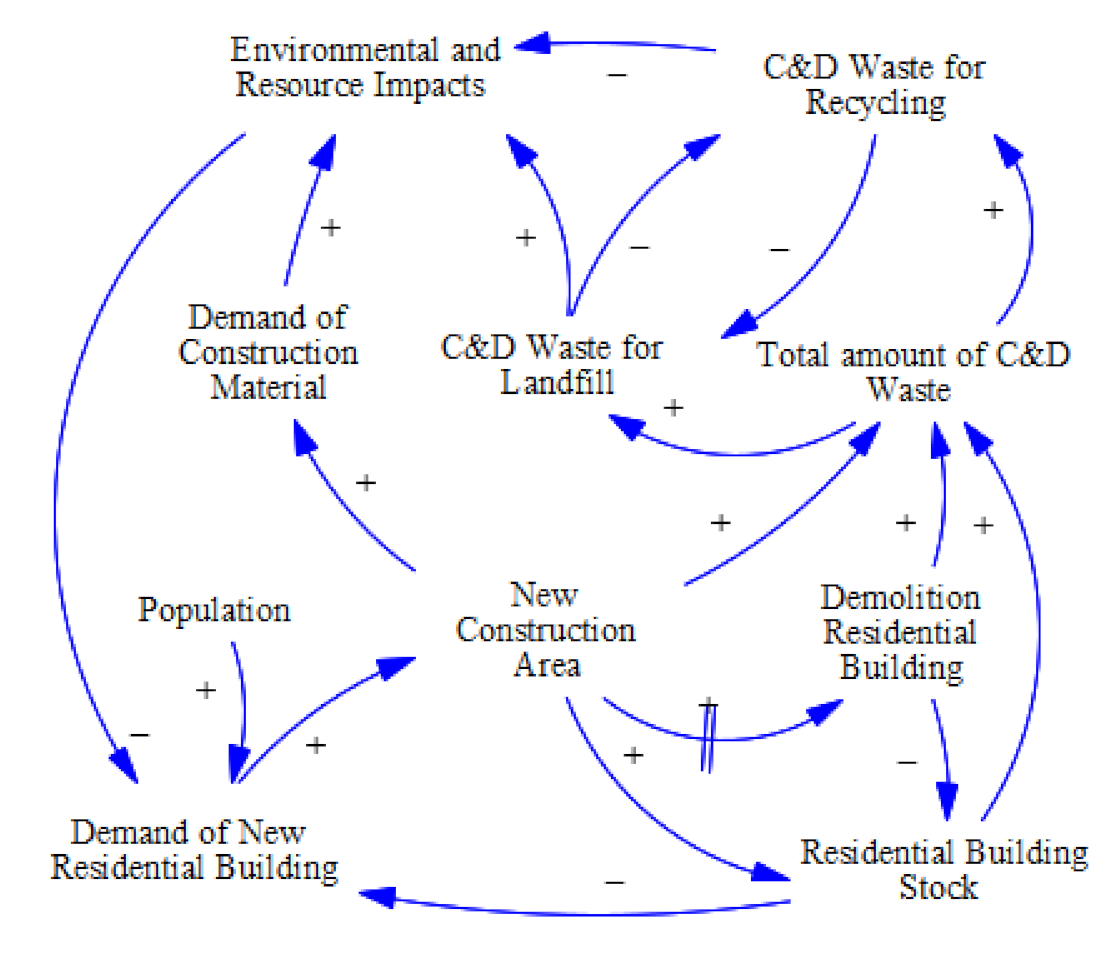

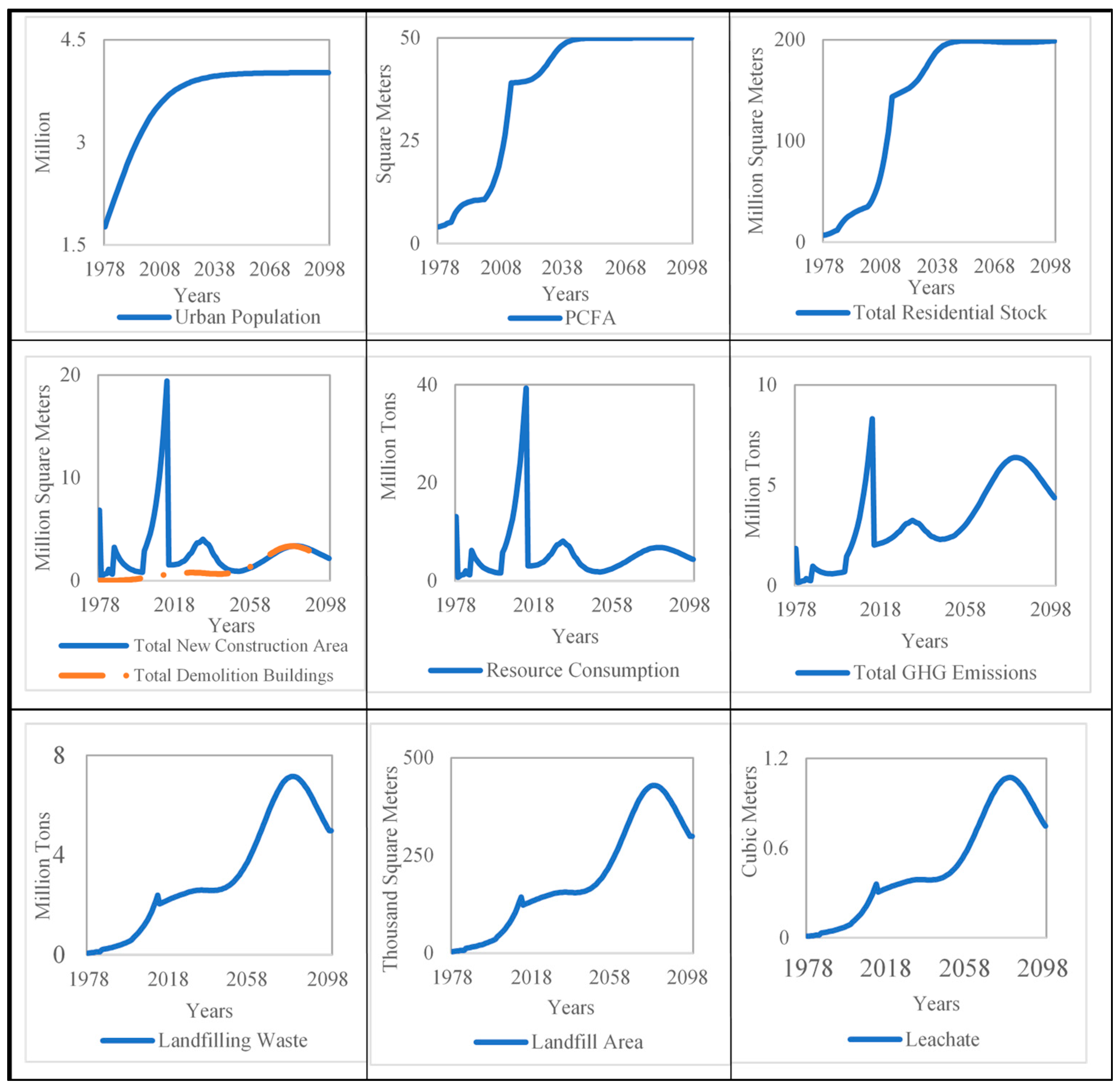
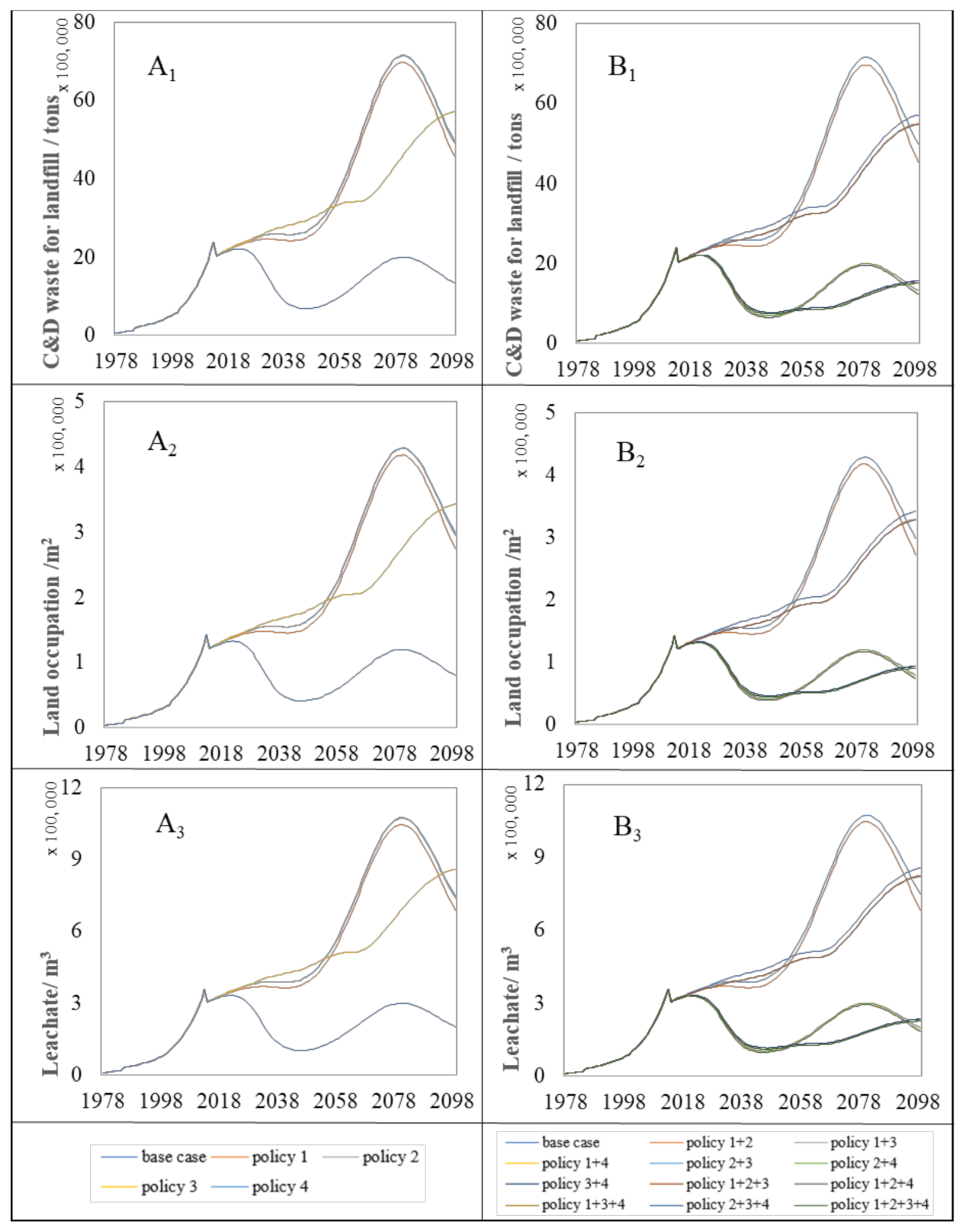
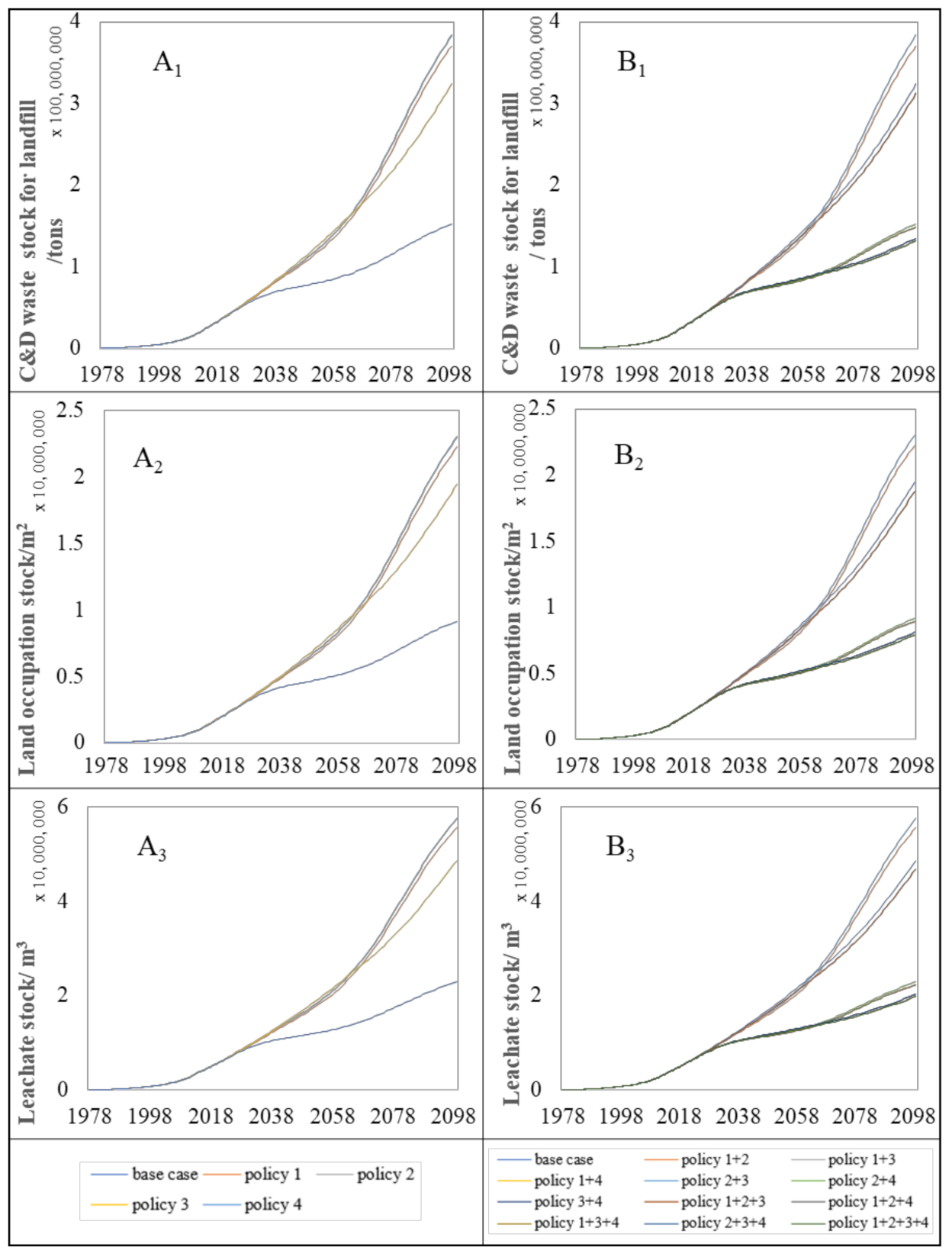
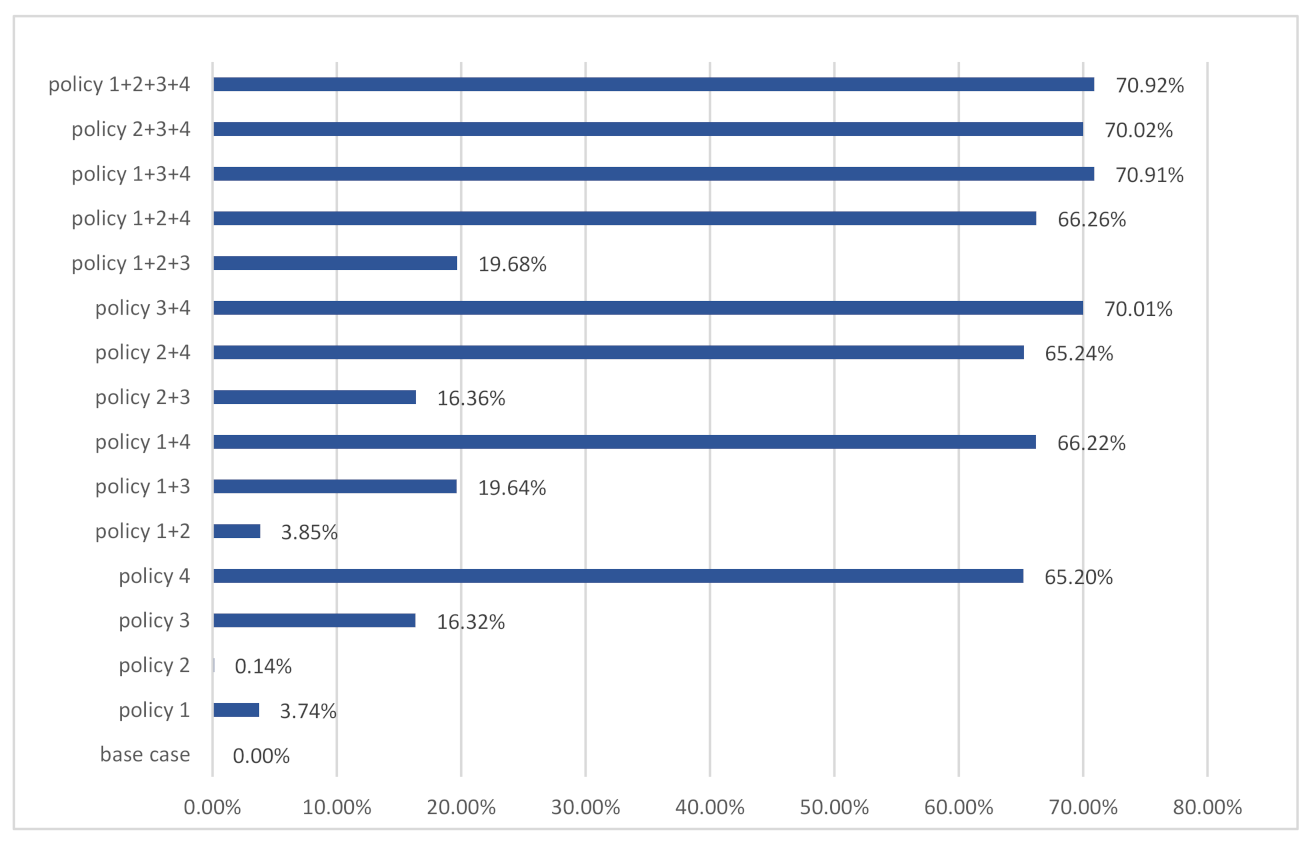
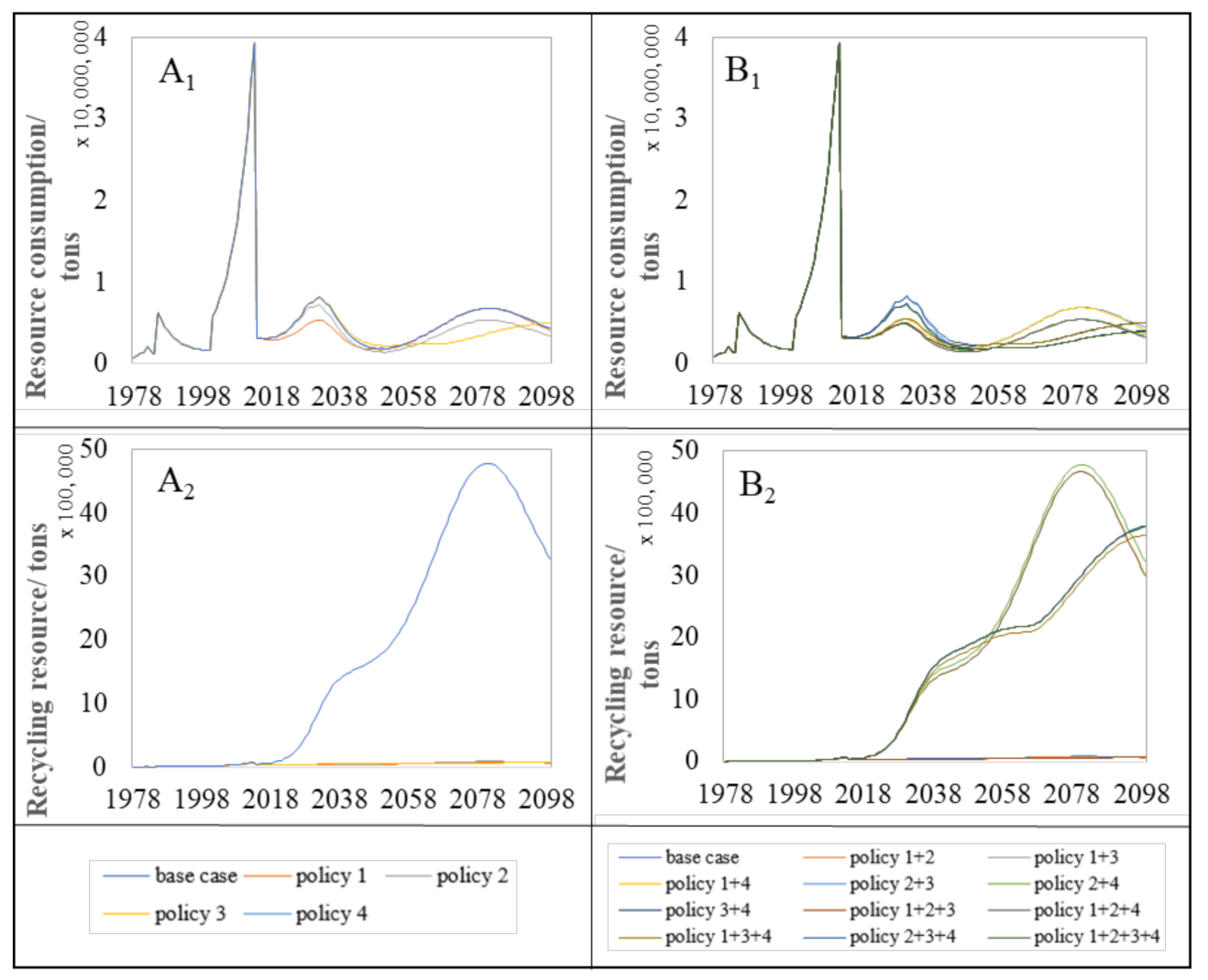
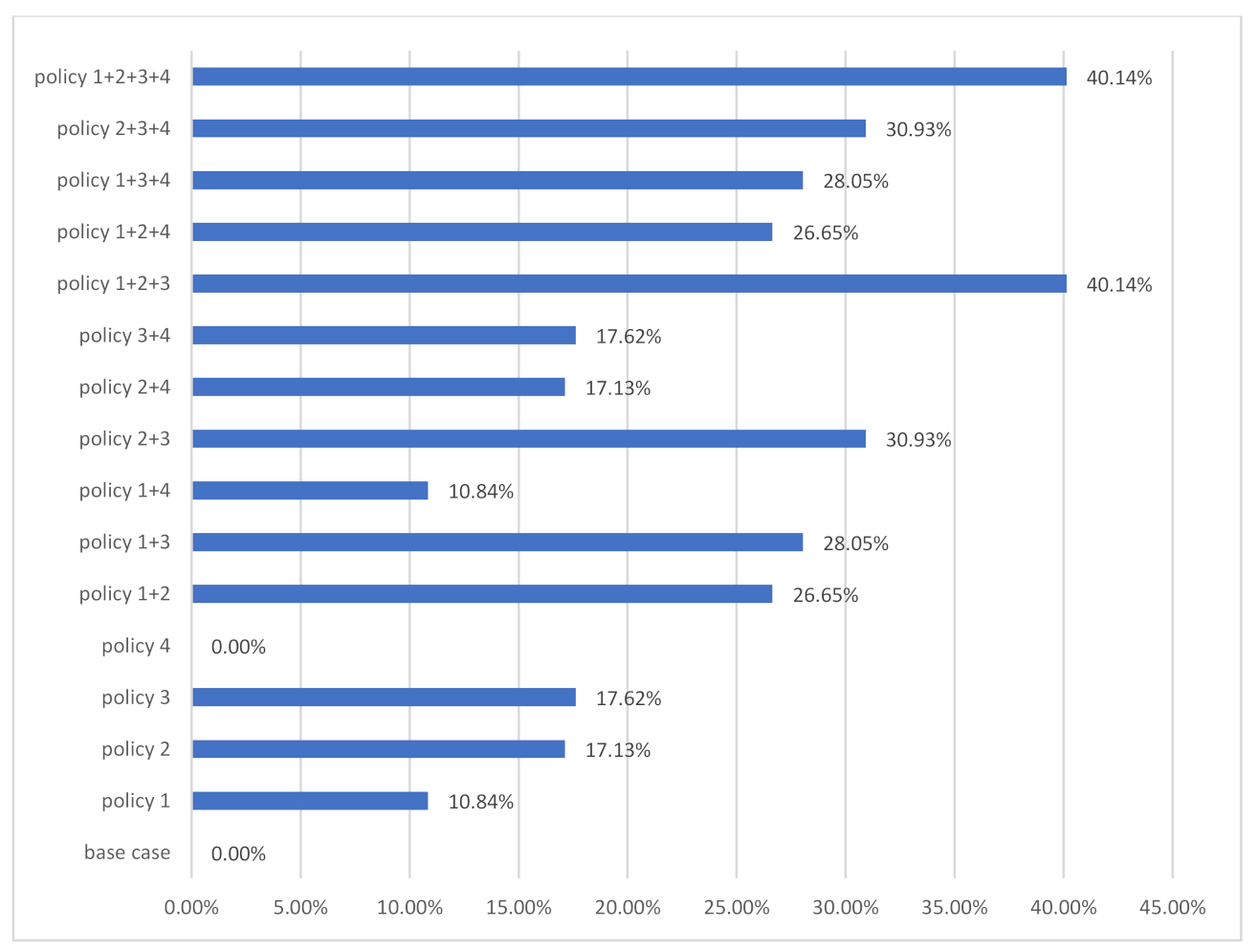
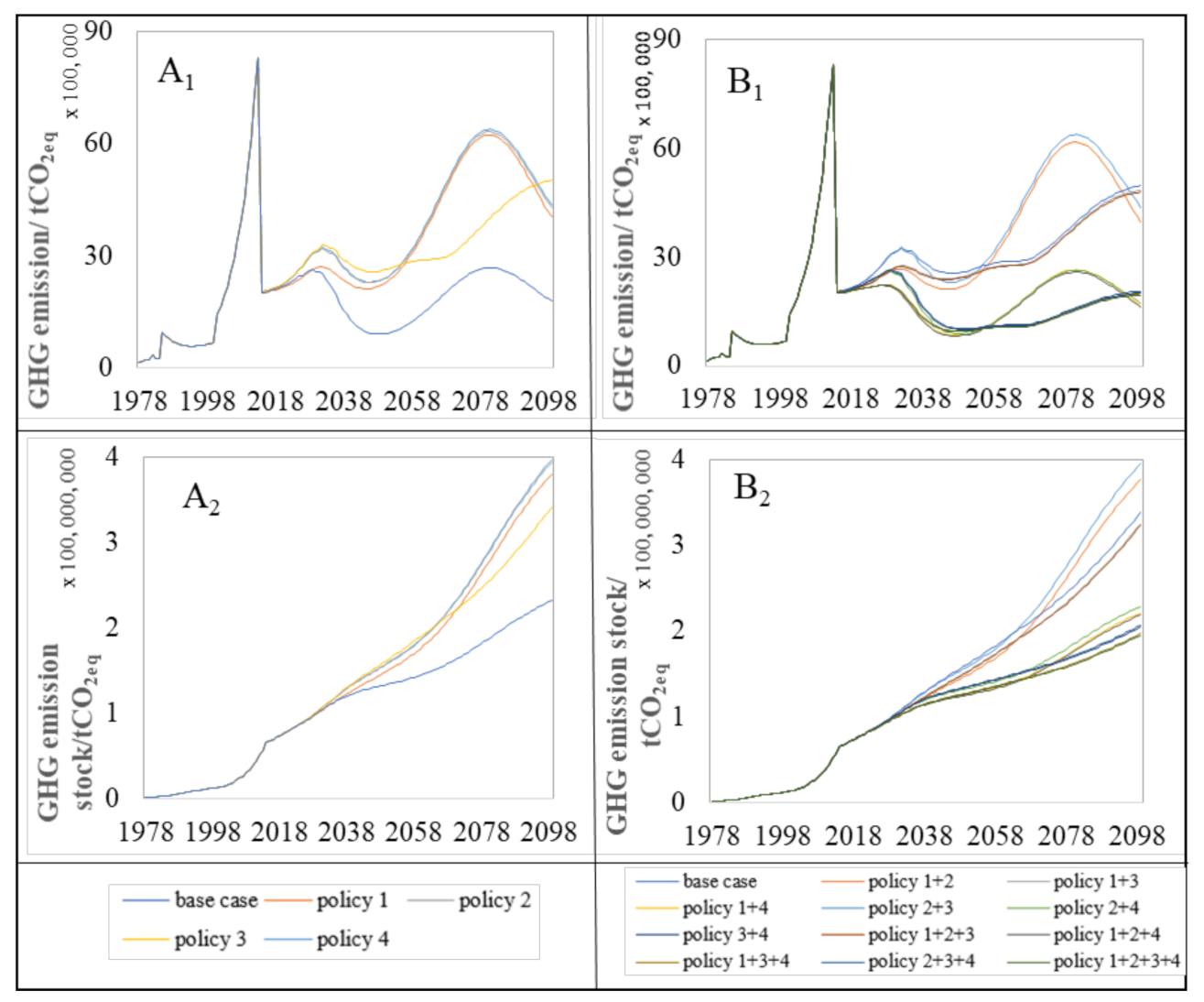

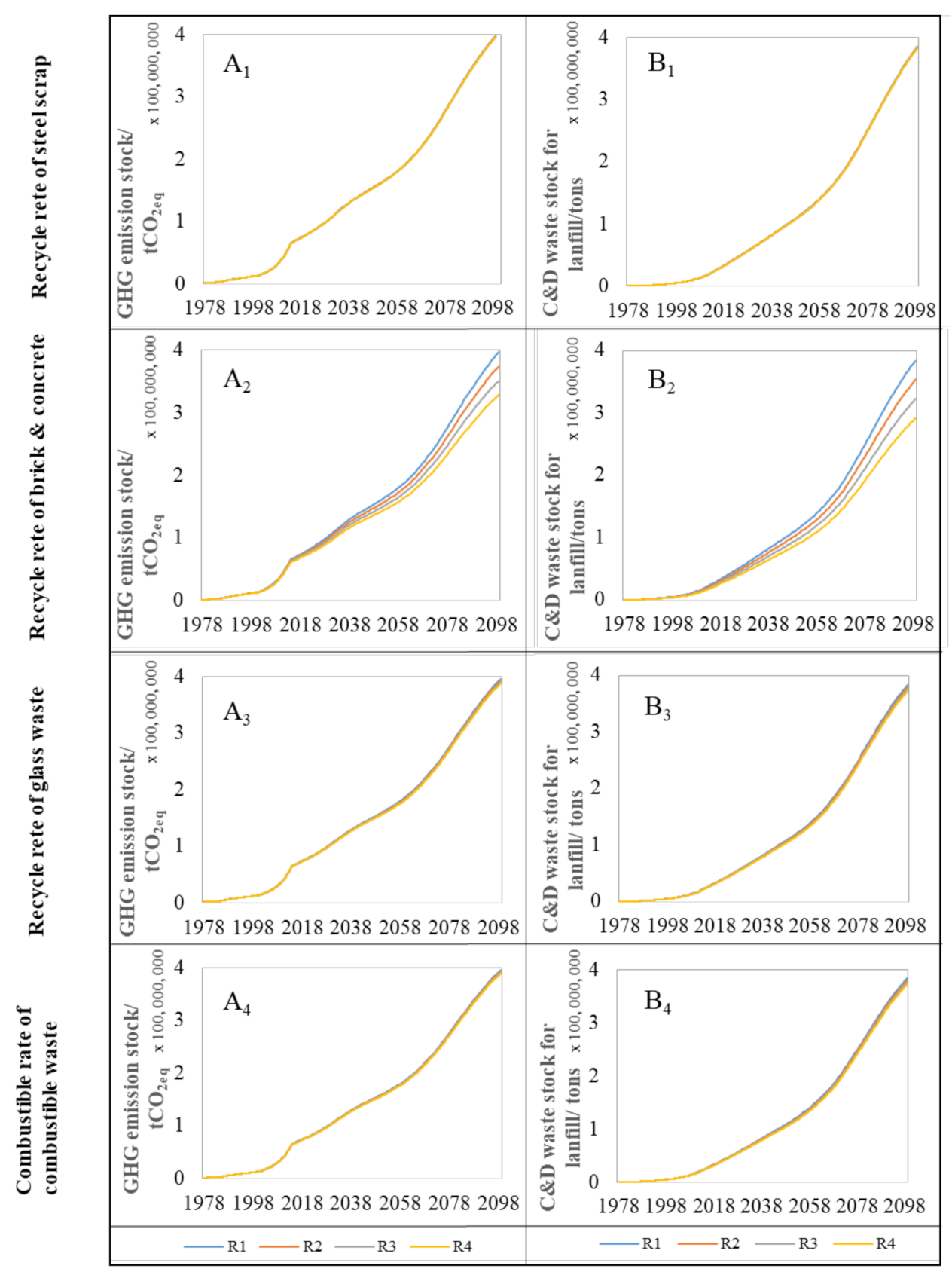
| Variable | Description | Unit | Initial Value | Date Source |
|---|---|---|---|---|
| Urban population | the total number of urban people | Million | 181 | Jinan statistic yearbook (1984) |
| PCFA | per capita residential building floor area | m2 | 4.06 | Jinan statistic yearbook (1984) |
| BC ratio | the ratio of new construction area with BC structure | % | 74.79 | Tabulation on the 2000 population census of Jinan city (2002) |
| SC ration | the ratio of new construction area with SC structure | % | 20.21 | Tabulation on the 2000 population census of Jinan city (2002) |
| S ratio | the ratio of new construction area with S structure | % | 5 | Tabulation on the 2000 population census of Jinan city (2002) |
| BC Stock | the residential building stock with BC structure | Million m2 | 436.7 | Jinan statistic yearbook (1984) |
| SC stock | the residential building stock with SC structure | Million m2 | 126.46 | Jinan statistic yearbook (1984) |
| BW stock | the residential building stock with BW structure | Million m2 | 62.57 | Jinan statistic yearbook (1984) |
| Total residential stock | the total residential building stock | Million m2 | 625.73 | Jinan statistic yearbook (1984) |
| Refurbishment rate | the rate of refurbishment residential building per year | % | 80 | Survey data of China Architecture Design & Research Group (2014) |
| Recycling rate of steel scrap | the rate of steel scrap by recycling per year | % | 0 | Survey data from Construction and Demolition sites |
| Recycling rate of brick and concrete waste | the rate of brick and concrete waste by recycling per year | % | 0 | Survey data from Construction and Demolition sites |
| Recycling rate of glass waste | the rate of glass waste by recycling per year | % | 0 | Survey data from Construction and Demolition sites |
| Combustible rate | the rate of combustible C&D waste disposal by incineration | % | 0 | Survey data from Construction and Demolition sites |
| Design Lifetime/Year | Actual Lifetime/Year | |
|---|---|---|
| BW | 40 | 30 |
| BC | 50 | 30 |
| SC | 70 | 40 |
| S | 80 | 50 |
| Coefficients | Unit | Value | Source | |
|---|---|---|---|---|
| Environmental pollution | Leachate | m3/t | 0.15 | Wang et al., 2007 |
| Land space occupation | m2/104 t | 0.06 | Yuan et al., 2006 | |
| GHG emission | C&D waste disposal by landfill | t CO2eq /t | 0.73316 | Fang, 2016 |
| C&D waste for incineration | t CO2eq/t | 0.002 | Fang, 2016 | |
| Steel production | t CO2eq/t | 1.96 | Ecoinvent | |
| Cement production | t CO2eq/t | 0.892 | ||
| Wood production | t CO2eq/t | 0.024 | ||
| Brick and Tile production | t CO2eq/t | 0.0521 | ||
| Sand production | t CO2eq/t | 0.0119 | ||
| Stone production | t CO2eq/t | 0.0663 | ||
| Glass production | t CO2eq/t | 0.731 | ||
| Linoleum production | t CO2eq/t | 1.06 | ||
| Pitch production | t CO2eq/t | 0.459 |
| Year | Urban Population/million | Urban Residential Building Stock/million m2 | ||
|---|---|---|---|---|
| Actual Data | Simulation Data | Actual Data | Simulation Data | |
| 1978 | 1.94 | 1.77 | 7.87 | 6.35 |
| 1979 | 1.88 | 1.84 | 7.94 | 7.31 |
| 1980 | 1.9 | 1.92 | 8 | 8.05 |
| 1981 | 1.92 | 2 | 8.45 | 8.74 |
| 1982 | 1.98 | 2.07 | 9.03 | 9.43 |
| 1983 | 2.03 | 2.15 | 10.03 | 10.13 |
| 1984 | 2.08 | 2.23 | 10.58 | 10.86 |
| 1985 | 2.11 | 2.3 | 11.01 | 13.06 |
| 1986 | 2.15 | 2.38 | 15.92 | 16 |
| 1987 | 2.19 | 2.45 | 16 | 17.4 |
| 1988 | 2.23 | 2.52 | 16.74 | 18.32 |
| 1989 | 2.27 | 2.59 | 17.02 | 19.08 |
| 1990 | 2.56 | 2.66 | 19.34 | 19.79 |
| 1991 | 2.85 | 2.73 | 21.65 | 20.49 |
| 1992 | 2.87 | 2.8 | 21.98 | 21.17 |
| 1993 | 2.9 | 2.86 | 22.61 | 21.85 |
| 1994 | 2.93 | 2.92 | 23.14 | 22.51 |
| 1995 | 2.97 | 2.98 | 23.75 | 23.17 |
| 1996 | 3.01 | 3.04 | 24.08 | 24.26 |
| 1997 | 3.05 | 3.09 | 24.7 | 26.04 |
| 1998 | 3.08 | 3.15 | 30.5 | 28.05 |
| 1999 | 3.12 | 3.2 | 31.15 | 30.16 |
| 2000 | 3.15 | 3.25 | 33.09 | 32.33 |
| 2001 | 3.2 | 3.29 | 34.22 | 40.93 |
| 2002 | 3.25 | 3.34 | 57.95 | 53.16 |
| 2003 | 3.31 | 3.38 | 62.43 | 59.23 |
| 2004 | 3.38 | 3.42 | 65.96 | 63.18 |
| 2005 | 3.45 | 3.46 | 67.41 | 66.37 |
| 2006 | 3.5 | 3.49 | 70.37 | 69.3 |
| 2007 | 3.53 | 3.53 | 74.03 | 72.11 |
| 2008 | 3.51 | 3.56 | 75.57 | 81.38 |
| 2009 | 3.49 | 3.59 | 102.68 | 96.78 |
| 2010 | 3.48 | 3.62 | 103.39 | 108.94 |
| 2011 | 3.49 | 3.64 | 105.67 | 119.79 |
| 2012 | 3.51 | 3.67 | 119.28 | 130.08 |
| 2013 | 3.54 | 3.69 | 133.29 | 140.13 |
| 2014 | 3.58 | 3.72 | 148.11 | 150.06 |
| 2015 | 3.63 | 3.74 | 163.25 | 158.12 |
| Error | 2.76% | Error | 1.44% | |
| Policy Measures Implication | Description | |
|---|---|---|
| Single policy | Policy 1: compact PCFA policy | The PCFA will be restricted 45 m2 from 2016 to 2100. |
| Policy 2: new technology policy | 65% of the new residential building will be building with steel structure by 2050. | |
| Policy 3: long lifetime policy | The lifetime of BC and SC and S building will be extended to 40 years, 50 years, and 60 years, respectively, from 2016 to 2100. | |
| Policy 4: high recycle rate policy | 90% of steel scraps, 70% of the cement and brick waste and 80% of the glass waste from C&D waste will be recycled respectively by 2050. 90% of the combustible C&D waste will be incinerated by 2050. | |
| Complex policy | Policy 1+2 | Policy 1+Policy 2 |
| Policy 1+3 | Policy 1+Policy 3 | |
| Policy 1+4 | Policy 1+Policy 4 | |
| Policy 2+3 | Policy 2+Policy 3 | |
| Policy 2+4 | Policy 2+Policy 4 | |
| Policy 3+4 | Policy 3+Policy 4 | |
| Policy 1+2+3 | Policy 1+Policy 2+Policy 3 | |
| Policy 1+2+4 | Policy 1+Policy 2+Policy 4 | |
| Policy 1+3+4 | Policy 1+Policy 3+Policy 4 | |
| Policy 2+3+4 | Policy 2+Policy 3+Policy 4 | |
| Policy 1+2+3+4 | Policy 1+Policy 2+Policy 3+Policy 4 | |
Publisher’s Note: MDPI stays neutral with regard to jurisdictional claims in published maps and institutional affiliations. |
© 2021 by the authors. Licensee MDPI, Basel, Switzerland. This article is an open access article distributed under the terms and conditions of the Creative Commons Attribution (CC BY) license (https://creativecommons.org/licenses/by/4.0/).
Share and Cite
Yang, D.; Dang, M.; Sun, L.; Han, F.; Shi, F.; Zhang, H.; Zhang, H. A System Dynamics Model for Urban Residential Building Stock towards Sustainability: The Case of Jinan, China. Int. J. Environ. Res. Public Health 2021, 18, 9520. https://doi.org/10.3390/ijerph18189520
Yang D, Dang M, Sun L, Han F, Shi F, Zhang H, Zhang H. A System Dynamics Model for Urban Residential Building Stock towards Sustainability: The Case of Jinan, China. International Journal of Environmental Research and Public Health. 2021; 18(18):9520. https://doi.org/10.3390/ijerph18189520
Chicago/Turabian StyleYang, Dong, Mengyuan Dang, Lingwen Sun, Feng Han, Feng Shi, Hongbo Zhang, and Hongjun Zhang. 2021. "A System Dynamics Model for Urban Residential Building Stock towards Sustainability: The Case of Jinan, China" International Journal of Environmental Research and Public Health 18, no. 18: 9520. https://doi.org/10.3390/ijerph18189520
APA StyleYang, D., Dang, M., Sun, L., Han, F., Shi, F., Zhang, H., & Zhang, H. (2021). A System Dynamics Model for Urban Residential Building Stock towards Sustainability: The Case of Jinan, China. International Journal of Environmental Research and Public Health, 18(18), 9520. https://doi.org/10.3390/ijerph18189520






